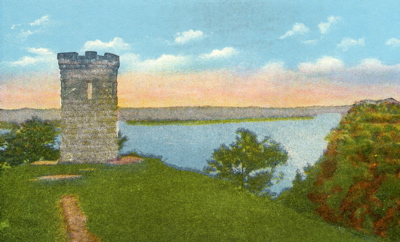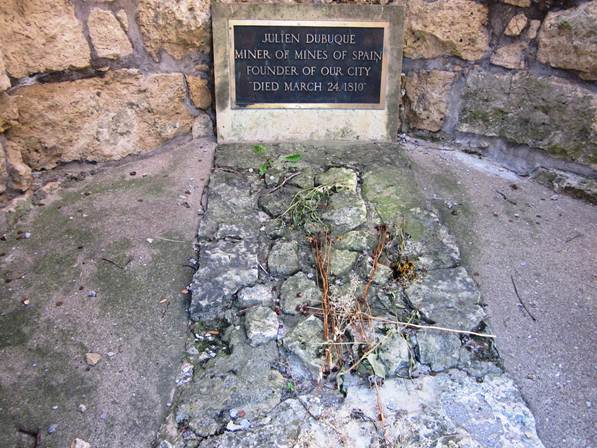Encyclopedia Dubuque
"Encyclopedia Dubuque is the online authority for all things Dubuque, written by the people who know the city best.”
Marshall Cohen—researcher and producer, CNN
Affiliated with the Local History Network of the State Historical Society of Iowa, and the Iowa Museum Association.
JULIEN DUBUQUE MONUMENT
JULIEN DUBUQUE MONUMENT. Julien DUBUQUE died of pneumonia on March 24, 1810 and was buried on the bluff above CATFISH CREEK. His grave was covered with a wooden and stone shelter complete with a gable roof and open window through which Native Americans believed the soul of the departed could leave. At the apex was a wooden cross made by white friends. The stone building was still intact in 1845. (1)
Controversy remains as to the inscription on the grave. George CATLIN who visited the grave in 1835 believed that Dubuque had written an inscription for himself giving his name, "Miner of the Mines of Spain," and his age. It is more likely that French Canadians left an inscription on a cedar cross. Several versions of these early years all agree that between 1827 and 1829 a cedar cross and cedar hut were constructed over the mound of rocks.
By the time of the CIVIL WAR, souvenir hunters had removed the hut and cross. (2) In 1895 the OLD SETTLERS' ASSOCIATION had begun work on arousing interest in erecting a monument over Dubuque's grave. (3) There was even an often repeated story that the bodies of Dubuque and Peosta had been discovered by a curio collector in a lead coffin and taken away during this time. (20) Franklin T. OLDT offered another story in his book The History of Dubuque County, Iowa. According to a Mrs. Dexter who lived south of the city, vandals broke into the grave and removed the lead coffin in which Dubuque's remains had been buried. They scattered the bones among stones and pieces of wood and stole the coffin. Mrs. Dexter found a lower jaw bone which she claimed was Dubuque's and kept it for years. (21)
Interest in a monument to Julien Dubuque was discussed at the November, 1892 meeting of the EARLY SETTLERS' ASSOCIATION. There was a definite sense of urgency expressed:
By all means let us get the monument up before ruthless destroyer
of traditions or matter of fact disputant of what is supposed to
be authenticated history comes along and proves that Dubuque was
only a myth. (22)
A visitor from Chicago attending the meeting offered a design and plan for a granite shaft thirty-seven foot high costing $3,700. He was also ready of offer a smaller version at a lower price. The man was reportedly upset when a competitor, William Gill, a local marble cutter mentioned that he had already submitted a design. The group generally agreed that the monument should be on the bluff over Catfish Creek and the suggestion was made to purchase a few acres for a park. (23)
On November 20, 1892 it was announced that the design of E. A. Fox of Chicago had been accepted by the Early Settlers Association. The base of the thirty-seven foot granite shaft would feature relief bronze plaques three feet in diameter showing scenes of Dubuque's first experience in the area. These bronzes would be manufactured in Brussels and would cost $300 each. The peak of the spire was designed to depict curtains drawn apart symbolizing "Dubuque's prophesy that a great city would grow up in this locality." Peter KIENE and Joseph HEROD agreed to donate four acres of land for the proposed park. Alderman Crawford suggested, however, that the city should purchase forty acres. With work to be completed by July 4, 1893 the suggestion was made to invite "all the great men of the nation" to a great celebration. (24)
The effort to secure funding failed. On August 8, 1895 the Dubuque Daily Herald reported that two young men had found the cross that marked Dubuque's grave missing, stones which had marked a square around it thrown about, and an attempt at an excavation of the grave visible. (25)
In 1895 the OLD SETTLERS' ASSOCIATION was still attempting to arouse interest in erecting a monument over Dubuque's grave. (26) On October 17, 1895 a group of citizens met to further those plans. (27) Chaired by Philip Pier with Alexander SIMPLOT as secretary, the meeting began with a history of Julien Dubuque. Simplot then moved that a committee of five people be appointed to gather contributions for the purchase of land and the erection of a monument. Judge Lenehan suggested that two people come from each of the city's wards. This was approved. (28) There were already two acres of land adjoining the site of the grave for the use of the Old Settlers' Association. One belonged to KIENE, Peter and the other was owned by Fridolin HEER. (29)
There were five burials found at the site of the present monument. As recorded by Richard HERRMANN: (7)
Julien Dubuque, lying down full length facing to the west
Chief PEOSTA, semi-sitting position, facing to the west
POTOSA, Julien Dubuque's wife, full length, facing to the west
Chief ROLLING CLOUD, a Fox Indian, sitting in the hut,
facing to the east
Gray Eagle, a Sauk Indian, sitting in the hut, facing to the
east
The remains discovered in the excavation were carefully reassembled and arranged for viewing at the HERRMANN MUSEUM, the curator's home. The Dubuque Sunday Herald stated that they were arranged "upstairs in a vacant room on a bare floor, where they were lying in perfect position." By his side were the bones of Peosta. The article indicated that many people were planning on visiting the construction site of the monument which was then seven feet tall. (8)
On October 31, 1897, the remains of Dubuque were encased in a walnut casket made by the DUBUQUE CABINET MAKERS' ASSOCIATION and then lowered four feet into the ground inside the monument which was constructed of Galena magnesia limestone quarried from the bluff. The final cost of the twelve-foot diameter, twenty-nine foot high structure was $560. The dedication of the monument was attended by more than two thousand people.
In 1907 members of the Old Settlers' Association offered the deed to the ground occupied by the monument and the small park around it to the county board of supervisors. The understanding was that the land would continue to be used for the park and monument exclusively. (9)
In 1931 an effort was made to provide public access to the grave site. Road construction proved difficult as the weather was warm and materials were not easily accessible. The decision was finally made to construct an ungraded road of cinders. Heavy iron boiler shells were used to fill in gullies and deep holes. (10)
Dedication ceremonies were scheduled for October 18, 1931. To add to the occasion, four-full-blooded SAUK from Tama County, Iowa were persuaded to perform. However when told they should stay in a wigwam at the site over the weekend, the Native Americans announced that they had no idea where one could be found or how to make one. The four who were to perform simply refused to live in such a dwelling and settled for a hotel room with free meals. (11)
Despite the problems, the dedication was a success. On the day of the death of Thomas Edison and the conviction of mobster Alphonse CAPONE for income tax evasion, more than one thousand people came to the dedication. Many arrived by car which cost them a twenty-five cent toll. The road was used for awhile, but washouts and the toll eventually led to people returning to the foot path up the hill. (12)
In 1963 eighteen acres of wooded land surrounding the grave of Julien Dubuque were made ready to be designated Julien Dubuque Park. The area included 12.3 acres donated by Herman LOTT and his wife Marcella and 5.8 acres owned by the City of Dubuque. About $28,000 had been allocated from state funds to develop the area along with $2,500 for survey and development work. The Chamber of Commerce Vacationland Committee, Dubuque County Conservation Board with city, county, and state officials had worked together to see that the project was completed. (13)
---
Source:
1. Brimberg, Judith. "Indian Trail Leads to Blufftop Grave," Telegraph Herald, May 17, 1959, p. 9. Online: http://news.google.com/newspapers?id=AJNFAAAAIBAJ&sjid=07wMAAAAIBAJ&pg=4613,1863282&dq=richard+herrmann+dubuque&hl=en
2. Ibid.
3. "Julien Dubuque," Telegraph Herald, Oct. 18, 1895, p. 8. Online: http://news.google.com/newspapers?id=m7BFAAAAIBAJ&sjid=LL0MAAAAIBAJ&pg=5047,5033246&dq=julien+dubuque&hl=en
4. Ibid.
5. Ibid.
6. Ibid.
7. "Julien Dubuque, Adventurous Spirit; Called Little Cloud by Fox Indians, Historian Declares," Telegraph Herald, Feb. 26, 1933, p. 9. Online: http://news.google.com/newspapers?id=4v1QAAAAIBAJ&sjid=Or4MAAAAIBAJ&pg=2539,2728957&dq=julien+dubuque&hl=en
8. "Viewed the Bones," Dubuque Sunday Herald, Oct. 9, 1897, p. 8. Online: http://news.google.com/newspapers?id=LCtBAAAAIBAJ&sjid=q6gMAAAAIBAJ&pg=4879,3956166&dq=julien+dubuque&hl=en
9. "Wish County to Preserve Ground," Telegraph Herald, June 18, 1907, p. 16. Online: http://news.google.com/newspapers?id=EtlBAAAAIBAJ&sjid=26kMAAAAIBAJ&pg=2625,4102350&dq=julien+dubuque&hl=en
10. Stowell, John. "Park at Julien Dubuque's Gravesite Not New Idea," Telegraph Herald, November 18, 1962, p. 21
11. Ibid.
12. Ibid.
13. "Plans Ready for Julien Dubuque Park," Telegraph Herald, Feb. 7, 1963, p. 28. Online: http://news.google.com/newspapers?id=Y49FAAAAIBAJ&sjid=5bwMAAAAIBAJ&pg=3194,4156713&dq=julien+dubuque&hl=en
Oldt, Franklin T. History of Dubuque County, Iowa. Chicago: Western Historical Company, 1880 http://www.ebooksread.com/authors-eng/franklin-t-oldt/history-of-dubuque-county-iowa-being-a-general-survey-of-dubuque-county-histor-tdl/page-23-history-of-dubuque-county-iowa-being-a-general-survey-of-dubuque-county-histor-tdl.shtml
Pratt, LeRoy G. Discovering Historic Iowa, Iowa Department of Public Instruction, 1975









